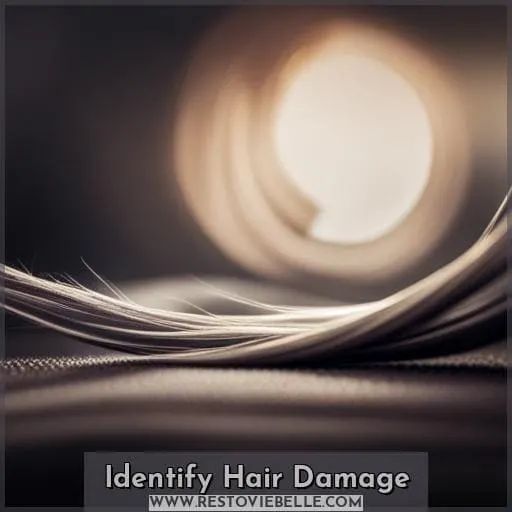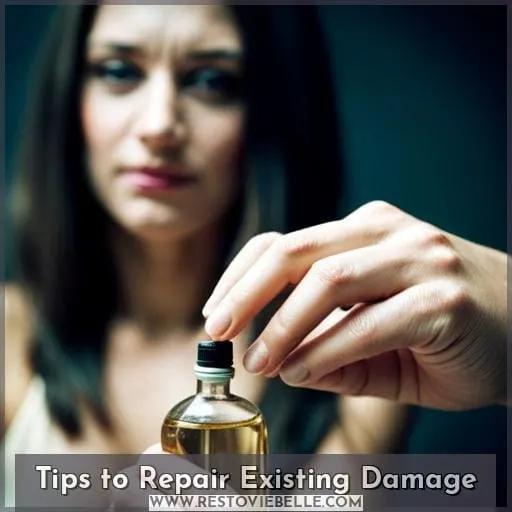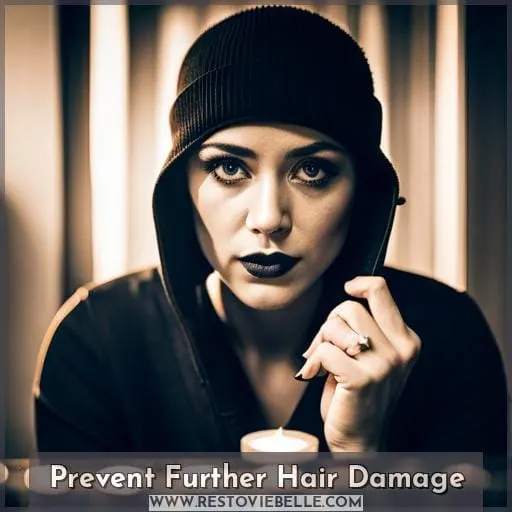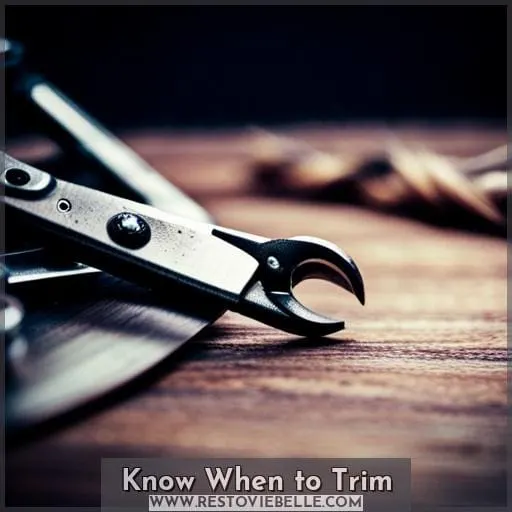This site is supported by our readers. We may earn a commission, at no cost to you, if you purchase through links.
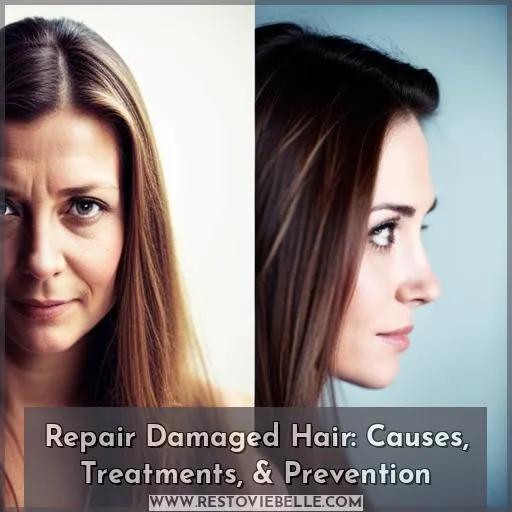 Imagine waking up to discover that your hair is dry, brittle, and damaged. You’re not alone – many people struggle with the effects of damaged hair. But don’t worry! There are steps you can take to repair and restore your locks to their former glory.
Imagine waking up to discover that your hair is dry, brittle, and damaged. You’re not alone – many people struggle with the effects of damaged hair. But don’t worry! There are steps you can take to repair and restore your locks to their former glory.
In this article, we will explore the causes of damaged hair, effective treatments for repairing it, and helpful tips for preventing further damage in the future.
Table Of Contents
- Key Takeaways
- Identify Hair Damage
- How Does Hair Get Damaged?
- Tips to Repair Existing Damage
- Prevent Further Hair Damage
- Know When to Trim
- Frequently Asked Questions (FAQs)
- Can damaged hair be completely repaired or is some level of damage permanent?
- What are some common signs of hair damage that may not be immediately obvious?
- Are there any natural remedies or DIY treatments that can help repair damaged hair?
- How long does it typically take to see results when repairing damaged hair?
- Are there any specific hairstyles or hair care practices that should be avoided to prevent further damage?
- Conclusion
Key Takeaways
- Deep conditioning treatments can help repair damaged hair by replenishing moisture and nutrients.
- Leave-in conditioners can protect damaged hair from further damage.
- Implementing protective styling techniques can prevent further damage to damaged hair.
- Lowering the use of heat tools and switching to satin pillowcases can help reduce friction and protect damaged hair.
Identify Hair Damage
To identify hair damage, look out for three key indicators:
- Split ends
- Porosity
- Elasticity
Split ends occur when the protective outer layer of the hair shaft breaks or frays.
Porosity refers to how well your hair absorbs and retains moisture – if it feels rough or easily gets tangled, it may be highly porous.
Lastly, check your hair’s elasticity by gently stretching a strand – healthy hair will bounce back while damaged strands will snap or take longer to return to their original shape.
By recognizing these signs of damage, you can take steps towards repairing and preventing further harm to your tresses.
Split Ends
If you notice split ends in your hair, it’s a clear sign that damage has occurred.
Split ends are caused by various factors such as:
- Mechanical damage from excessive brushing or tight hairstyles
- Chemical damage from harsh treatments like coloring or perming
- Heat damage from frequent use of styling tools
To treat split ends, trimming the damaged hair is essential.
Prevention tips include:
- Using heat protectants
- Avoiding excessive heat styling to minimize further damage.
Porosity
How can you determine the porosity of your damaged hair?
Understanding hair porosity is crucial in assessing and treating damaged hair. Here are four ways to identify the porosity level of your locks:
- Perform a Porosity Test: Submerge a strand of clean, dry hair in water and observe how it reacts.
- Use the Porosity Scale: Categorize your results as low, normal, or high based on how quickly or slowly water is absorbed.
- Assess Hair Cuticles: Examine if they lay flat (low porosity) or lift up easily (high porosity).
- Look for Signs of Damage: Loss of gloss, lackluster appearance, and weakened protein structures indicate porous hair.
Elasticity
You can easily identify hair damage by testing its elasticity. Hair elasticity refers to the ability of your hair strands to stretch and return to their original shape without breaking.
To test your hair’s elasticity, gently stretch a strand between your fingers and see if it snaps immediately or stretches before returning back. A healthy strand should have good bounce-back and minimal breakage during this test.
Understanding the level of damage based on the results from the elasticity test is important in determining appropriate treatments for restoring hair health. There’s an established scale that categorizes different levels of loss in terms of elastic properties: low, medium, high, and very high.
If you notice significant breakage or lackluster bounce-back during the elasticity test, it indicates that you may need specific treatments targeted at improving overall strength and flexibility:
- Hair strengthening products: Look for shampoos, conditioners,
and leave-in treatments specifically designed to strengthen weak
hair strands.
- Heat damage control: Limit exposure to heat styling tools like
curling irons or straighteners as they can weaken protein bonds,
leading to reduced resilience.
- Sulfate-free products: Opt for gentle sulfate-free shampoos
and conditioners that help retain moisture while minimizing further
damage caused by harsh chemicals.
By incorporating these strategies into your regular routine along with proper care such as avoiding tight hairstyles and excessive brushing when wet will help restore lost vitality in damaged locks by rebuilding their natural capacity for stretching without snapping easily.
How Does Hair Get Damaged?
Chemical treatments, heat styling, and improper brushing are common culprits for hair damage.
As an expert in the field with years of experience working with clients dealing with damaged hair, I can assure you that these factors contribute significantly to the weakening of your hair’s structure.
Chemical treatments such as dyeing or bleaching strip moisture from the hair shaft, while excessive heat from styling tools can cause dryness and breakage.
Additionally, using harsh brushes or brushing aggressively can lead to physical damage like split ends and breakage.
Understanding how these actions harm your hair is crucial in taking steps towards repair and prevention.
Chemical Treatments
By frequently subjecting your hair to chemical treatments such as coloring or perming, you can cause significant damage. Chemical processing breaks down the hair’s natural bonds, leading to weakened and brittle strands.
To repair damaged hair from chemical treatments:
- Use bond-building products like Olaplex No. 7 Bonding Oil.
- Switch to sulfate-free products for gentle cleansing.
- Protect your hair with heat protectant products before styling tools.
These steps will help restore strength and vitality to chemically processed hair while preventing further damage in the future.
Heat Styling
To avoid heat damage to your hair, it’s important to properly understand the effects of heat styling.
Heat styling tools such as curling irons and flat irons can cause significant damage if not used with caution.
Always use heat protectants before applying any hot tools to your hair.
Lower the temperature settings on your styling tools and limit their use to prevent excessive damage.
Taking these precautions will help prevent heat-related hair damage and maintain healthy locks.
Improper Brushing
Brushing your hair improperly can lead to significant damage and weaken its overall health.
Here are some ways improper brushing can harm your hair:
- Tangles and knots cause breakage.
- Using the wrong brush type or brushing too frequently can cause damage.
- Improper comb technique can result in breakage as well.
- Brushing vigorously on wet, fragile hair causes more harm than good.
To prevent further damage, opt for a wide-tooth comb or gentle brush, consider silk pillowcases, and be mindful of sleep styles.
Tips to Repair Existing Damage
To repair existing damage in your hair, deep conditioning treatments and leave-in conditioners are essential.
Deep conditioning treatments penetrate the hair shaft to nourish and strengthen damaged strands, while leave-in conditioners provide ongoing protection and moisture throughout the day.
These products work together to restore health, shine, and resilience to your damaged hair.
Deep Conditioning Treatments
To repair existing damage, nourish your hair with deep conditioning treatments.
Deep conditioning treatments are an essential part of any hair care routine for restoring moisture and repairing damaged strands. These treatments typically involve applying a rich, nutrient-packed formula to your hair and leaving it on for a specific amount of time to allow the ingredients to penetrate deeply into the hair shaft.
The frequency and length of these treatments may vary depending on the severity of damage and individual needs. When done consistently over time, deep conditioning treatments can yield impressive results in strengthening and revitalizing damaged hair.
| Frequency | Length |
|---|---|
| Once a week | 20-30 minutes |
Deep conditioning treatment formulas often contain key ingredients such as proteins (like keratin), natural oils (such as argan oil or coconut oil), vitamins (like vitamin E), humectants (such as glycerin or honey) that help restore moisture, repair structural damage, reduce breakage, enhance shine & manageability.
Leave-in Conditioners
For repairing existing damage, you can benefit from using leave-in conditioners to nourish and protect your hair.
Leave-in conditioners are lightweight and perfect for use on wet hair. They not only provide essential hydration but also help detangle your locks, making styling easier.
Additionally, they offer heat protection to shield your strands from damage caused by styling tools.
Leave-in conditioners are convenient for travel as well, ensuring that your hair stays healthy wherever you go.
Prevent Further Hair Damage
To prevent further hair damage, it’s crucial to:
- Implement protective styling techniques.
- Lower the use of heat tools.
- Switch to satin pillowcases.
Protective styles such as braids or buns can help minimize exposure to environmental factors that contribute to damage.
Lowering the temperature on your heat tools and using them sparingly can reduce the risk of excessive heat damage.
Finally, opting for satin pillowcases instead of cotton ones reduces friction and helps prevent breakage while you sleep.
By incorporating these practices into your daily routine, you can effectively protect your hair from further harm and promote its overall health and strength.
Protective Styling
To prevent further hair damage, try incorporating protective styling into your routine.
- Using satin bonnets or silk pillowcases to minimize friction and protect your strands while you sleep.
- Using heat protectants and lowering the temperature on your styling tools to reduce heat damage.
- Opting for wide-toothed combs for detangling instead of brushes that can cause breakage.
- Considering braids, twists, buns, or other updos that keep your hair protected from external elements like hats or scarves.
| Protective Styling Options | Benefits |
|---|---|
| Braids | Protects natural texture |
| Twists | Minimizes manipulation and breakage |
| Buns | Keeps ends tucked away |
Lower Heat Tools
Lower the heat settings on your styling tools to prevent further damage to your hair.
- Heat Damage and Hair Types: Different hair types have varying levels of tolerance to heat, so adjusting the temperature can minimize damage.
- Heat Damage and Hair Porosity: High temperatures can strip moisture from porous hair, leading to dryness and breakage.
- Heat Damage and Hair Texture/Color/Length: Fine or delicate textures, colored or chemically treated hair, and long lengths are more susceptible to thermal damage.
By lowering the heat on your tools, you’ll protect your precious locks from unnecessary harm while still achieving desired styles.
Satin Pillowcases
Switching to satin pillowcases can help prevent further hair damage.
Satin is a smooth fabric that reduces friction, allowing your hair to slip and glide effortlessly while you sleep. This helps reduce frizz, prevent breakage, and improve the overall shine of your hair.
Additionally, satin pillowcases are gentle on color-treated hair, helping protect the vibrancy of your dye job for longer.
Consider investing in satin or silk pillowcases to minimize hair wear-and-tear and wake up with healthier-looking locks.
Know When to Trim
Knowing when to trim your damaged hair is essential for its repair and overall health.
As an expert in damaged hair care, I recommend implementing the search and destroy method by regularly inspecting your hair for split ends and trimming them as needed.
Additionally, scheduling regular trims every 6-8 weeks can help prevent further damage from traveling up the hair shaft.
Avoid blunt cuts that can exacerbate existing damage, opting instead for layered cuts that promote healthier-looking locks.
Search and Destroy
You should regularly search and destroy split ends to maintain healthy hair.
Trimming split ends is essential for preventing further damage and promoting hair growth.
As a trained professional with expertise in damaged hair, I recommend using leave-in conditioners to protect the ends from dryness and breakage.
Additionally, maintaining a healthy diet rich in vitamins and minerals can promote overall hair health.
Avoiding harsh chemicals and heat tools will also help prevent further damage.
Regular Trims
To maintain healthy hair and prevent further damage, it’s important to regularly trim your hair.
Trimming helps get rid of split ends and promotes healthier growth.
But how often should you trim? It depends on the individual, but a general guideline is every 6-8 weeks.
If you notice split ends or your hair feels dry and brittle, it’s time for a trim.
Regular trims are different from major haircuts as they focus on removing damaged ends while preserving length.
To keep your strands in good shape between salon visits, learn how to safely do minor trims at home using sharp shears.
Avoid Blunt Cuts
To prevent further damage, it’s important to consider avoiding blunt cuts when determining the right time for a trim.
Blunt cuts can exacerbate hair damage and lead to more breakage and split ends.
Instead, opt for trims in layers or angled cuts that add movement and texture while removing damaged ends.
Stylists often use point cutting techniques or texturizing shears to achieve long layers without sacrificing length.
This approach helps maintain healthier hair while still achieving your desired style.
Frequently Asked Questions (FAQs)
Can damaged hair be completely repaired or is some level of damage permanent?
Yes, damaged hair can be repaired to a certain extent through various treatments and practices. However, it’s important to note that some level of damage may be permanent depending on the severity and type of damage.
What are some common signs of hair damage that may not be immediately obvious?
Discover the hidden signs of hair damage:
- Unexplained hair loss
- Excessive dryness or brittleness
- Lackluster appearance
These subtle clues may indicate underlying damage that needs immediate attention for healthy and revived locks.
Are there any natural remedies or DIY treatments that can help repair damaged hair?
To repair damaged hair, try natural remedies like:
- Coconut oil masks
- Honey masks
DIY treatments such as:
- Egg yolks
- Aloe vera
Experiment and find what works best for you!
How long does it typically take to see results when repairing damaged hair?
How long does it take to see results when repairing damaged hair?
Results vary depending on the severity of damage and individual factors. With proper care, improvement can be noticeable within a few weeks, but full recovery may take several months.
Are there any specific hairstyles or hair care practices that should be avoided to prevent further damage?
To prevent further damage, avoid tight hairstyles that pull on your hair.
Limit the use of heat styling tools and opt for air-drying whenever possible.
Be gentle when brushing or detangling to minimize breakage.
Conclusion
To bring your damaged hair back to life, it’s important to first identify the signs of damage, such as:
- Split ends
- Porosity
- Lack of elasticity
Knowing the causes of hair damage, such as:
- Chemical treatments
- Heat styling
can help you avoid further harm.
[Keypoints]Treatments like deep conditioning and leave-in conditioners can help repair existing damage, while:
- Protective styling
- Using lower heat tools
can prevent future harm.
So say goodbye to damaged hair and hello to beautifully restored locks!
